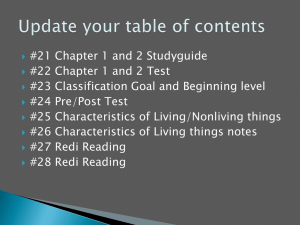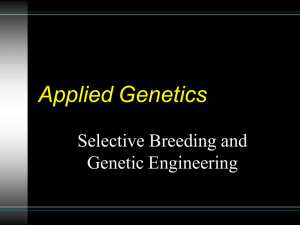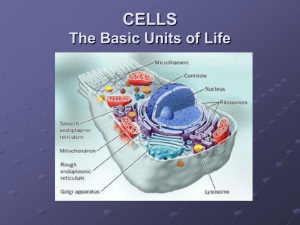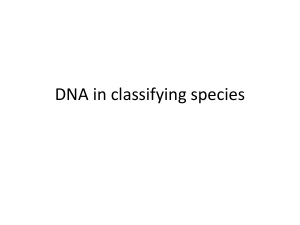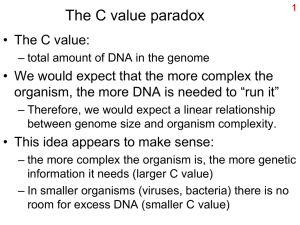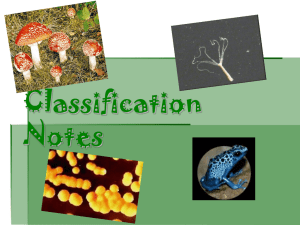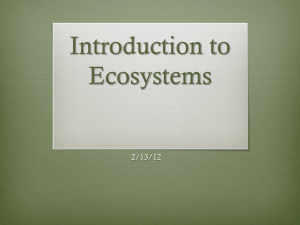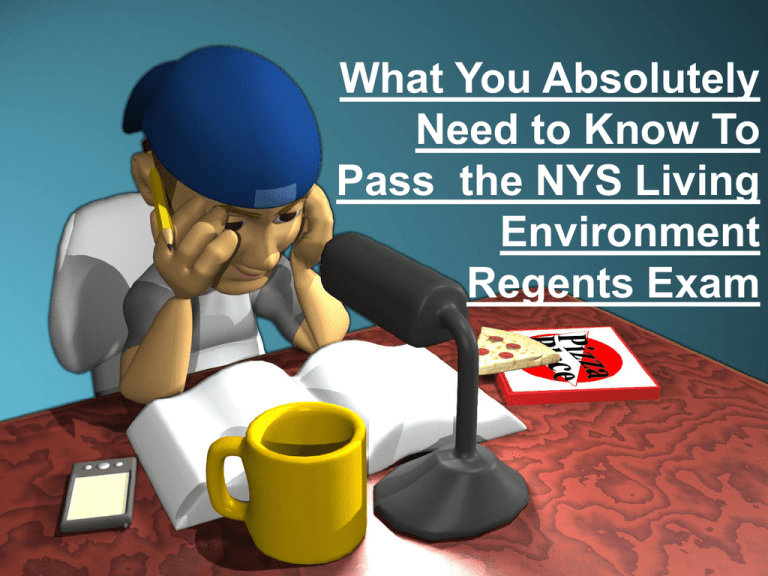
What You Absolutely
Need to Know To
Pass the NYS Living
Environment
Regents Exam
The LE Exam consists of
approximately 75
questions worth a total of
85 points. The exam is
broken down into 4 parts:
• Part A: General knowledge multiple
choice questions (30 points)
• Part B: A mix of multiple choice and short
answer, dealing with the application of
knowledge. So far, Part B has always
required students to draw a line graph.
(25 points)
• Part C: Short answer questions
dealing with your ability to apply
material learned in the course to real
world situations. (15 points)
• Part D: Multiple choice and short
answer, pertaining to the 4 NYS labs
performed during the school year. (15
points)
• The state requires all answers to be
recorded in such a way that they can
not be tampered with. As such, all
answers on the test must be written
in permanent pen, and mistakes may
not be “scribbled out.”
Topic One: The Scientific Method
A. Terms:
1. Observation: What is seen or
measured.
2. Inference: A conclusion based on
observation or evidence.
3. Hypothesis: A prediction based on
available evidence. A good
hypothesis states both cause and
effect.
a. A correct hypothesis can be
tested and falsified (proven
incorrect) using an experiment.
b. The easiest way to write a
correct hypothesis is as an “ifthen” statement. (ex: If I give
patients this pill, then they will
not get sick.)
4. Theory: An explanation of
natural events that is
supported by strong evidence.
a. Theories tie together many
scientific facts, hypotheses
and laws.
b. Misconception: “Theories
are things that are opinions,
or are not proven.” This is
an incorrect use of the word
“theory” in a scientific
context. A scientific theory is
not a simple guess or
conjecture, and is strongly
supported by evidence.
B. Controlled Experiment:
Compares the results of an
experiment between two (or
more) groups.
1. Experimental group: Group
being tested or receiving
treatment.
2. Control group: “Normal”
group. Should be identical to
experimental group in every
way except one: it does not
receive the new treatment.
3. Placebo: A sugar pill or other
“fake” treatment given to the
control group.
4. Independent Variable:
Variable that is being tested
(ex: new drug, new fertilizer).
a. The “If” part of an “If-then”
hypothesis.
b.The independent variable
is always plotted on the X
axis.
5. Dependent Variable:
Variable that is measured
at the end of an
experiment; the results.
a.The “then” part of an
“If-then” hypothesis.
b.The dependent variable
is always plotted on the
Y axis.
C. Characteristics of a good
experiment:
1. Can be repeated the same
way and get the same
results.
2. Have large sample size/many
test subjects.
3. Are performed for longer
periods of time.
4. Test only one
independent variable. All
other characteristics of
the tested groups should
be the same.
5. Are peer reviewed –
examined by several
scientists to determine
its accuracy.
6. Must test the hypothesis
and show whether it is
wrong or right.
7. Is objective – the
experiment and
conclusion are fair and
unbiased. Fact and
opinion are not mixed.
8. The experiment follows
established ethical and
legal standards
D. Graphs and Data Tables
1. Data tables are used to
organize data which will be
plotted in a graph.
a. First column in the table is
for the independent
variable.
b.Second column is another
for the dependent variable.
c.Each column should be
titled, and include units
of measurement.
d.Data in the table must
be arranged in
ascending or
descending order.
2. Both the x and y axis of the
graph must be labeled or
titled. These labels are
typically the same ones
used in the data table.
Once again units of
measurement must be
written with the title.
3. The independent variable
is always plotted on the
x-axis.
4. The dependent variable is
always plotted on the yaxis.
5. The x and y axis must be
numbered.
a. These numbers must
increase by a uniform
increment (that is you
must count by 1’s, 2’s, 5’s,
10’s, etc).
b.Your numerical scales
should take up most of the
axes. Squeezing it all into
the bottom corner makes
the graph impossible to
read and no credit will be
given.
c.The numbers must line
up with the grid lines of
the graph, not with
spaces between them.
d.You do not need to
start numbering your
axis with 0.
6. To date, all graphs drawn on
the LE Regents have been
line graphs. Any student who
draws a bar graph instead of
a line graph will be denied
credit for this part of the test.
7. All points plotted on your
graph must be surrounded
by a circle (or sometimes a
square or triangle,
depending on the directions)
Topic Two: Chemistry of Living
Things
I. All living things must
maintain homeostasis in
order to stay alive.
A. Homeostasis:
• maintaining a stable
internal environment
B. Failure to maintain
homeostasis results in
illness or death
C. Homeostasis is often maintained
using feedback mechanisms.
1. Feedback mechanisms are
cycles in which the product of
one reaction causes another to
start or stop.
D. While organisms are balanced,
they are not unchanging. The term
used to describe the balanced
state is dynamic equilibrium.
1. Dynamic Equilibrium: A
balanced state created by
many small, opposing
changes.
Feedback Mechanism
II. Life Processes: All living
things carry out the same
basic chemical processes.
Taken together, these
process make up an
organism’s metabolism
A.Metabolism:
• all life processes needed
to maintain homeostasis
1.Nutrition: Using
nutrients for growth,
synthesis, repair and
energy.
2.respiration Converts
energy in food into a
usable form (ATP).
3. Synthesis: Making complex
chemicals from simple
substances.
4. Transport: Absorbing and
distributing materials
throughout the body.
5. Regulation: The control and
coordination of life processes.
6. Excretion: Removing of wastes
produced by metabolic
activities.
7. Heredity: Passes on genes to
offspring.
III. Inorganic Chemicals: Simple
compounds
A. Water ( H2O) : Most common
substance in all living things
(about 60% of body mass)
• Needed for chemical
reactions (won’t happen
in “dry” conditions)
• Dissolves other
molecules into solution,
allowing them to be
transported through the
body.
B. Oxygen (O2): Needed by most (not all)
organisms for chemical respiration.
• Released by plants and algae as a
waste product of photosynthesis
• Aerobic respiration: Process that
uses oxygen to extract energy
from glucose (sugar). Used by
most organisms.
• Anaerobic respiration: Process
that extracts energy from glucose
without using oxygen. Gives less
energy, so only used by some
simple organisms (some bacteria,
yeast). These organisms do not
need to breathe in oxygen.
C.Carbon Dioxide (CO2):
With water, used by
plants to make glucose
(photosynthesis).
• Waste product of
aerobic respiration.
D.Nitrogen (N2): Most common
gas in air (70%)
• Needed to make protein.
• Converted into
ammonia by soil
bacteria. Nitrates are
absorbed by plants and
then eaten by animals.
• Excreted as waste in
sweat or urine
E. Acids and Bases: Used for
different functions in body
(such as digestion).
• Measured by the pH scale
• Very high and very low
pHs are usually lethal.
• pH can affect rates of
chemical reactions; for
example, digestive
enzymes work fastest in
acidic environments,
which is why we make
stomach acid
(hydrochloric acid, or
HCl).
IV. Organic Compounds:
Larger, more complex
chemicals. Always contain
the elements carbon (C)
and hydrogen (H).
Synthesized from simpler
substances (building
blocks).
A.Carbohydrates: are
sugars and starches
1.Building blocks:
carbon, hydrogen,
oxygen
2.Functions:
• Immediate source of
energy
• Stored energy
(starch)
• Structure (cellulose)
B.Lipids: fats, oils, waxes
1.Building Blocks:
carbon, hydrogen,
oxygen
2.Functions:
• Stored energy
• waterproofing
• make up membranes
• insulates and
cushions
C.Proteins: Complex
compounds that carry out all
the body’s activities.
1. Building blocks: carbon,
hydrogen, oxygen,
nitrogen
2. After water, proteins are
the most plentiful
substances in the body.
3. Have many different
functions as determined
by their shape
Proteins cont’d
4.Lock and Key Model:
Proteins must have the
right shape to “fit” with
other molecules.
• Changing the shape
of a protein will
change what it can
interact with its
function.
5. Important types of
proteins:
• Hormones and
neurotransmitters –
carry messages through
the body.
• Cell receptors – in cell
membrane; receive
hormones and
neurotransmitters.
• Antibodies – attack
foreign pathogens
• Enzymes- act as catalysts,
controlling all chemical
reactions in the body.
• High temperatures will cause
enzymes to denature (lose
their shape) and stop
functioning. This is why high
fevers are dangerous.
• pH fluctuations will also
cause enzymes to denature
and stop functioning
D.Nucleic Acids (DNA
and RNA):
1.Functions:
• Make up genes
and
chromosomes.
• Store and transmit
hereditary
information
2.Building blocks:
Nucleotides
• 5-carbon sugar
• Phosphate group
• Nitrogenous base
• Adenine
• Guanine
• Cytosine
• Thymine/Uracil
Topic Three: The cell
The Cell
I. Definition: basic unit of
living things
II.
Cell Theory has three parts:
1. All living things are made of
one or more cells
– Unicellular – single celled
organisms (amoeba,
paramecium)
– Multicellular – have more
than 1 cell; may be only a
few (vorticella), or many
trillions of cells
(humans). Almost all
structures in multicelled
organisms are made of or
by cells.
Cell Theory cont’d.
3.Cells carry out all of an
organism’s life
functions
• Everything you do is
the result of the work
of your cells – walking,
talking, even thinking
and feeling. When you
get sick, it is because
your cells are not
working correctly.
Cell Theory cont’d.
3.All cells come from
pre-existing cells
• This seems obvious
now, but at one time
people believed in
spontaneous
generation, the idea
that living things
regularly emerged from
nonliving things.
B.Exceptions to the Cell
Theory
1. Viruses are not made of
cells. However, they also
do not carry out all life
processes, so many
biologists do not consider
them true living things.
2. The first cell obviously
could not come from
another cell.
III. Cell Organelles: These are the
tiny cell parts that make up a
cell.
1. Nucleus
• Controls the cell
• Contains hereditary
material (chromosomes,
genes, DNA)
2. Cytoplasm
• Fluid/liquid in the cell
• Helps transport material
• Mostly water
3. Mitochondria
• Carries out chemical
respiration.
• Gives cell energy
(Powerhouse of the cell).
4. Ribosomes
• Makes proteins from amino
acids.
5. Vacuoles
• Stores food, water and
waste
• Food vacuoles may digest
large molecules.
• Waste vacuoles may excrete
waste out the cell
membrane
6.Chloroplast
• Carries out
photosynthesis
• Plant and algae cells
only
7.Cell Wall
• Gives shape,
structure and
protection.
• NEVER found in
animal cells.
8. Cell Membrane (plasma
membrane)
• Separates cell interior from
environment
• Controls what enters and
leaves the cell using
selective permeability
• Has receptor molecules that
pick up signals from other
cells.
• Has antigens which are
proteins that identify the
cell; prevent the cell from
being attacked by the
immune system.
Cell Membrane cont’d.
• Small molecules (like O2, H2O, CO2,
and sugars) can pass freely through
the cell membrane through diffusion.
• movement of molecules from high
concentrations to low concentrations.
Requires no energy (passive
transport).
• Large molecules (like proteins and
starches) cannot pass through the
cell membrane without the help of
transport proteins.
• The basic types of proteins in the cell
membrane are:
• Receptor proteins
• Transport proteins
• Antigens.
Cell Membrane cont’d
• If the cell must use energy (ATP)
to move a molecule, it is called
active transport.
• requires the use of energy,
usually moving molecules from a
low concentration to a high
concentration (against the flow of
diffusion).
• Osmosis is the diffusion of water
into or out of the cell. If water
diffuses into the cell, the cell
swells (get larger) and may burst.
If it loses water (being put in salt
water for example) it will shrivel
up.
Topic Four: Nutrition,
Photosynthesis and Respiration
•
Reminder: All life processes
are chemical activities which
make up your metabolism.
I. Nutrition: Taking in nutrients
(food) for various activities
including:
1. growth
2. development
3. Reproduction
4. repair
A. Ingestion: taking food into your
body
B. Digestion: food is broken down so
that the molecules are small
enough to enter cells
1. Nutrients must be broken down
into smaller parts so that they
can be diffused into the blood
and cells of organisms.
• Starches are digested into
simple sugars
• Proteins are digested into
amino acids
C.Autotrophic Nutrition:
Organisms take inorganic
materials (CO2, H2O) and
convert them into organic
nutrients (glucose).
1.Auto = self ; troph = feed so
Autotroph = self-feeder –
makes their own food
2.Photosynthesis is most
common form of autotrophic
nutrition
3.Ex: plants, algae, and some
bacteria
D. Heterotrophic Nutrition:
Organisms must obtain nutrients
made by other organisms.
1. Hetero = other, so Heterotroph
= other-feeder – eats other
organisms.
2. All consumers and
decomposers are heterotrophs.
3. Includes:
• Carnivores: meat eaters
• Herbivores: plant eaters
• Omnivores: eats both
plants and animals
• Decomposers: eats dead or
decaying matter
II.
Photosynthesis: Process in which
sun’s energy is trapped in the
chemical bonds of sugar.
A. Requires water, carbon dioxide
and light
B. Makes glucose (sugar) as food.
C. oxygen is a waste product.
D. Benefits:
1. Provides food for all plants,
animals and other
organisms.
2. Provides oxygen to breathe.
3. Removes carbon dioxide
from atmosphere.
E. Plant adaptations:
1. Chloroplast: Cell organelle
that does photosynthesis
2. Gas exchange:
• Stomates : openings under
a leaf; let gases in and out
• Guard cells: open and
close stomates to prevent
dehydration
3. Transport:
• Xylem and Phloem: “tubes”
transport food and water
throughout the plant
III. Respiration: Process that takes
energy from sugar molecules
and places it in molecules of
ATP.
A. ATP is the molecule all life
uses for energy.
• No organism can get
energy from sunlight or
sugar without first
putting the energy into
ATP.
B. Requires glucose and oxygen
C. Carbon dioxide and water are
waste products.
D. Most organisms carry out aerobic
respiration (uses oxygen) in their
mitochondria.
E. Anaerobic respiration does not
require oxygen, but gives less
ATP (energy) for each molecule of
sugar.
• When exercise causes
human muscles to run out
of oxygen, their cells will do
anaerobic respiration. The
waste product, lactic acid,
causes muscles to “ burn”
so that you will stop.
F. Photosynthesis and
Aerobic Respiration are
opposite reactions! They
are also important in
cycling oxygen, carbon,
hydrogen and water
through the environment
G) Common mistakes:
•
•
•
•
“Plants use photosynthesis, animals use
respiration.”
• All organisms, including plants, use
respiration to get their energy.
“Respiration is breathing.”
• Breathing is not respiration. Breathing
exchanges the gases needed for
respiration. Inhaling and exhaling does not
give you ATP.
“Oxygen is used to breathe.”
• This is backwards. Breathing is used to get
oxygen which is used for respiration.
Without oxygen, you have no respiration,
no ATP, and no energy.
“All living things need oxygen/need to
breathe.”
• Anaerobic organisms do not need oxygen,
and do not have to breathe.
Topic Five: The Human Body
I. Organization: The human
body is made up of cells.
A. All humans (and most
other organisms) begin
life as a single cell.
1. This single cell is
called a zygote.
2. The nucleus of this
cell has all the genes
needed to become a
complete organism
B.Humans grow as a result
of mitosis (cell division).
1. This quickly increases
the number of cells in
the body until there
many trillions of cells.
2.Since all new cells
come from the same
single cell, they all
share the same DNA.
C. As cells divide, they begin to
develop into specialized tissues.
1. Specialization or
Differentiation: Process in
which a cell changes to have a
special shape and function.
2. Cells specialize by turning
specific genes on or off.
• Ex: A white blood cell has
turned off all genes needed
to make skin, bone, or
nerves. It still has those
genes, but only the genes
needed to be a white blood
cell remain turned on.
D.As the body continues to
develop, tissues will work
together to form organs
E.Organs will work together
to form organ systems .
F.Organ systems will work
together to help a person
maintain homeostasis
II.
Nervous System
A. The nervous system regulates your
body with electrochemical impulses
1. The chemical portion of a nerve
impulse is called a
neurotransmitter
2. A stimulus is a change in the
environment that an organism
responds to.
3. Neurotransmitters released by 1
nerve cell are received by chemical
receptors in the cell membrane of
the next nerve cell.
4. The shape of the receptor molecule
determines which neurotransmitter
it can receive.
B.A nerve cell is also called
a neuron
C.The main organs of the
nervous system are the
brain and spinal cord
D.The spinal cord controls
reflexes and relays
impulses between the
brain and body
III. Endocrine System
•
Uses hormones to regulate the body.
1. A hormone is a chemical
messenger secreted by
endocrine glands.
2. Hormones are slower than nerve
impulses, but with longer lasting
effects.
3. Hormone levels are controlled by
feedback mechanisms.
4. Receptor molecules on the
surface of the cell membrane
receive hormones. As with all
proteins, it is the shape of the
receptor molecule that
determines which hormone it can
receive.
Feedback Mechanism example
B. The pancreas makes insulin and
glucagon which control blood
sugar.
• Common mistake: “Insulin
lowers blood pressure.”
• Insulin (and glucagon)
directly control blood sugar
(or glucose) levels, not
blood pressure.
C. Adrenal glands make adrenaline
when the body is under stress.
D. Testosterone (male), estrogen and
progesterone (female) are the sex
hormones. These are made in the
gonads (testes for males, ovaries
for females).
IV.
Circulatory System
A. Moves material through the body
to the organs and cells that need
them.
B. Transported material includes:
1. water and nutrients from
intestines to all cells of
body.
2. oxygen from lungs to all
cells of the body.
3. hormones from glands to
target cells
4. wastes from all cells to the
excretory organs.
C. Materials usually enter and leave
the blood through diffusion.
1. Diffusion: Process in which
material moves from a high
concentration to a low
concentration.
• Ex: There is a high
concentration of oxygen in
the lungs, so oxygen will
diffuse from the lungs into
the blood, which has less
oxygen.
2. capillaries Microscopic blood
vessels where diffusion occurs.
D.The heart is the pump that
drives the circulatory
system.
E. Red blood cells carry
oxygen and carbon dioxide
i. Hemoglobin: Protein in
red blood cells that
carries oxygen. Plasma
is the fluid of the blood.
It transports everything
except oxygen.
F. Platelets clot the blood
Common mistakes:
1. “The heart pumps oxygen to the
brain.”
– Technically true, but the heart
pumps blood (which carries the
oxygen) everywhere in your
body.
2. “Oxygen diffuses into and out of
the heart.”
– No materials diffuse in or out of
the blood when it is in the
heart. This only occurs in
capillaries.
V.
A.
B.
C.
D.
E.
Respiratory System:
Breathing provides oxygen needed for
chemical respiration (which uses energy
from sugar to make ATP).
Excretes the waste, carbon dioxide,
which is produced from chemical
respiration.
The diaphragm is the muscle that allows
breathing to occur.
You breathe faster when CO2 builds up in
the blood (not when you need oxygen).
The alveoli are microscopic sacs where
oxygen enters the blood and CO2 leaves
the blood.
1. The alveoli are surrounded by
capillaries which pick up oxygen
and drop off CO2.
VI. Digestive System:
A. Food is broken down so that it is small
enough to enter the body
tissues/cells.
1. Food is broken down mechanically
and chemically.
2. Nutrients and water are absorbed
into the body by diffusion in the
small and large intestines.
B. The digestive system is a one way
passage through the body that
includes the mouth, stomach and
intestines.
C. Food is moved through the digestive
system by muscular contractions
(peristalsis).
D. Undigested food is eliminated as solid
waste (feces)
VII.Excretory System:
A. Removes waste produced
by the cells of your body.
1. These wastes include
salt, urea, carbon
dioxide and water.
B. Lungs excrete CO2 and
H2O
C. The skin excretes salts
and water as sweat.
D. The kidneys excrete urea and
water and other substances as
urine.
1. Kidneys also control amount of
water in your body.
E. The liver filters toxins and dead
red blood cells from the blood.
F. Common mistake:
1. “The body excretes feces.”
• Feces never enter cells of the
body, so technically it is not
excreted. The correct term is
“eliminated” or “egested.”
VIII. Immune System
A. The job of the immune
system is to protect the
body against pathogens
B. Pathogen: a disease
causing agent
1. Types of pathogens
include viruses,
bacteria, and
parasites.
C. White Blood Cells are the main
components of the immune
system.
1. Different w.b.c’s have different
roles, including:
• Identify pathogens
• “Tag” pathogens for
destruction by other w.b.c's.
• Destroy pathogen by eating
it – phagocytosis
• Destroy pathogen using
chemicals (poking holes)
• Make antibodies
D. Antibodies are proteins made by white
blood cells to attack pathogens.
1. Every antibody is specific in its action
– it can attack one and only one type
of pathogen. As with all proteins, this
is because the shape of the antibody
must fit its target (lock and key model).
E. Antigens are protein “tags” that identify a
cell or virus.
1. Your blood type is determined by your
antigens (you can have A or B
antigens, both or nether (type O).
2. Any cell of virus with the wrong
antigen will be seen as foreign by your
immune system, attacked, and
destroyed. This is why you must
match blood types before receiving
blood or an organ transplant.
F. A vaccine is an injection of a dead or
weakened pathogen.
1. Triggers the body to make antibodies
against that pathogen.
2. Effective against both viruses and
bacteria.
3. Can only prevent disease, not cure it.
G. Antibiotics are drugs used to stop
infections by bacteria.
1. Antibiotics will not work against
viruses.
2. Unlike vaccines, antibiotics can cure
diseases.
H. Common mistake:
• “Antibodies are cells that attack
pathogens.” Antibodies are proteins,
not cells.
IX.
Interactions between body
systems
A.
The different systems of the body
work together to maintain
homeostasis. For example:
1. Nutrients from the digestive
system are transported to cells
by the circulatory system.
2. Wastes from the respiratory
system are removed by the
excretory system.
3. The nervous and endocrine
systems work together to control
the body.
4. The immune system protects the
body from disease.
X.
Diseases and Disorders
A. Typically the exam asks
you to name a disease,
what causes it, its effect
on the body, and how to
prevent/treat/cure it. The
most important diseases
and disorders for you to
know are:
1. AIDS
•
•
•
•
Caused by HIV virus (a pathogen)
Weakens human immune system,
leaving body vulnerable to other
diseases.
Spread through bodily fluids,
usually sexual contact, intravenous
(IV) drug use (sharing needles), or
blood transfusions.
Can’t be cured, but spread may be
prevented by sexual abstinence,
“safe” sex (using condoms), not
sharing needles, or testing blood
before using it for a transfusion.
2. Cancer
•
•
•
•
Caused when a cell reproduces
(divides) at an uncontrolled rate,
forming a tumor.
Cancer cells do not specialize and
take resources from healthy tissue.
May be caused by radiation,
chemicals (such as asbestos or
cigarette smoke), and viruses.
Treatments include surgery,
radiation therapy, and
chemotherapy.
3. Diabetes
• Affects body’s ability to
control blood sugar.
• Some diabetics may be
treated using injections of
insulin made by genetically
engineered bacteria.
4. Sickle Cell Anemia
•
•
•
•
Sickle cell disease is a common
genetic disorder found in African
Americans
Caused by a mutation in the gene
that codes for the protein
hemoglobin. This change
substitutes the amino acid valine for
glutamic acid.
Characterized by the bent and
twisted shape of the red blood cells
Produces physical weakness and
damage to the brain, heart, and
spleen. In some cases, it may be
fatal.
5. Allergies
• Occur when immune
system overreacts to a
harmless substance (such
as pollen)
• Asthma is a form of allergy
caused by a reaction to
dust particles in the air.
Topic Six: Reproduction
I.
Asexual reproduction:
A. Advantages: faster and
easier
B. Disadvantage: no
variety; offspring are the
same as the parent
II. Sexual reproduction:
A. Advantage: variety due to
the recombination of
genes
B. Disadvantage: more time,
effort, and risk
III. Mitosis
A.
B.
C.
D.
D.
Used in all forms of asexual
reproduction.
The number and types of
chromosomes in the daughter cells
are the same
as in the parent cell.
Large organisms use mitosis for
growth and repair
1. Simple organisms use it to
reproduce.
One division of a cell two
identical, diploid (2n) cells.
1. Diploid: Cell with a complete set
of chromosomes.
IV.
A.
Meiosis
Makes gametes used in sexual
reproduction.
1. Gamete: Sex cells; egg and
sperm
B. One cell divides twice four
DIFFERENT haploid (1n) cells.
1. Haploid: Cell with half set of
chromosomes ( ½ normal)
C. Separates pairs of chromosomes
so that offspring get one
chromosome of each pair from that
parent.
D. Each daughter cell (gamete) gets
only one half of the chromosomes
of the “parent” cell.
V.
Male Reproductive System
A. Testes produce and store
sperm.
1. Sperm are haploid cells made
by meiosis
2. Sperm are produced in large
numbers throughout a males
life
3. Sperm are smaller than the
egg and mobile
4. Sperm only provide offspring
with 23 chromosomes –
everything else is in the egg.
Male Reproductive System cont’d
B. Testosterone is the male
sex hormone, and is made
in the testes.
C. Penis transfers sperm into
the female reproductive
system.
D. Semen is the fluid that
carries sperm.
1. Semen contains sugar to
give sperm energy.
VI.
Female Reproductive System
A. Ovaries produce eggs.
1. Eggs are haploid cells made
by meiosis
2. Females are born with all
eggs they will ever need.
• An egg is not fully
developed until ovulation
• Females are born with
millions of eggs, enough
for several lifetimes.
Female Reproductive System
cont’d
3. Eggs are largest cells in the
body.
4. Eggs do not move on their
own.
5. Contain 23 chromosomes
and all cell parts
(mitochondria, ribosomes,
etc) that the offspring will
need to grow and develop.
Female Reproductive System
cont’d.
B. The menstrual cycle lasts 28 days
(on average)
1. Ovulation – release of an egg
(typically 1 per cycle)
2. Menstruation – shedding of the
uterine wall if fertilization doesn’t
occur
3. If pregnancy occurs, the
menstrual cycle will temporarily
stop.
Female Reproductive System
cont’d.
C. The fallopian tube carries
the egg to the uterus.
D. The uterus is the womb
where the baby will
develop.
E. The vagina is the birth
canal where the baby will
leave the body.
VII. Development
A.
B.
1.
2.
3.
4.
Fertilization occurs in the fallopian tube
(oviduct)
1. A fertilized egg is called a zygote
2. Fertilization restores the complete set
of chromosomes, so the zygote is
diploid (23 from the egg + 23 from the
sperm = 46).
A zygote develops in the following order:
Cleavage – A form of division; cells divide
but do not differentiate
Differentiation – Cells begin to form into
tissues and organs
Embryo
Fetus - most major organs are formed (but
not completed)
•
Continues to grow through cell division
(mitosis)
Development cont’d
C. The placenta transfers nutrients and
oxygen from the mother’s blood into the
blood of the fetus through the process
of diffusion
1. The blood of the mother and fetus do
not mix.
2. The fetus is attached to the placenta
by the umbilical cord
3. Waste produced by the fetus is also
removed by the placenta.
• Waste (CO2, urea, salts) diffuse
from placenta into mother’s blood.
• Since the fetus does not eat solid
food, it does not have to eliminate
feces.
Development cont’d
D. The child is vulnerable to
alcohol, drugs, etc because
organs and systems are still
developing.
Topic Six: Genetics
I.
Chromosomes:
A. Humans have 46
chromosomes, or 23
homologous pairs.
1. Homologous: Each
chromosome from one
parent has a
corresponding
chromosome from the
opposite sex parent
B.Chromosome pairs carry
genes for the same traits.
1.Most organisms have
two genes (alleles) for
each trait - 1 from each
parent, 1 on each
member of the
homologous pair.
C. Sex chromosomes – In humans,
females are X and males are Y
1. The Y chromosome is much
smaller than the X, so it is
missing many genes. This
means many genes on the X
chromosome do not have a
“partner” so:
• If a male has a recessive
trait on the X chromosome,
the Y chromosome will not
be able to “hide” it with a
dominant gene, so...
• This makes males more
likely to have some traits
(like color blindness). These
are called sex linked traits.
D.Common mistake:
“Humans have 23
chromosomes (or 46
pairs of chromosomes, or
some other incorrect
number).”
– These numbers are often
confused. You must
memorize them correctly
II.
A.
Chromosomes and Genes
Each chromosome has hundreds or
thousands of genes.
B. Each gene codes for a particular
protein.
1. Common mistake: “Genes/DNA
are made from protein.”
• Genes carry the instructions
to make protein. The genes
themselves are made from
nucleic acids.
2. While genes determine our traits,
the environment can affect
expression of genes.
III. DNA
A. DNA is the chemical that
makes up your genes and
chromosomes.
1. Analogy: If your genes and
chromosomes are the
“instruction manual” for
your body, DNA would be
the paper it is printed on.
B. The shape of a DNA molecule
is a double helix which
resembles a twisted ladder.
DNA cont’d.
C.The shape of DNA allows it
to replicate (copy) itself
almost perfectly.
D.DNA is made of 4 bases:
ATGC
1.Base pairs: A-T and G-C
• in RNA the pairs are
G-C and A-U
IV.
•
Protein Synthesis:
This is how genes control
your body:
A. A codon is a sequence of
three bases in DNA.
• Each codon represents a
specific amino acid.
• Ribosomes assemble
amino acids in the same
order that they are listed in
the DNA codons.
• The amino acids will make a
protein
Protein Synthesis: cont’d
• The order of the amino acids
(determined by the DNA
sequence) determines the
shape of the protein.
• The shape of a protein
determines its function
• Therefore: The sequence of
bases in DNA will determine the
functions of all the proteins in
the body.
• The proteins build and run the
body.
B. mRNA carries the genetic code
to ribosomes.
• The order of DNA bases in your
genes determines the order of
amino acids in your proteins,
which determines the protein’s
structure and function
• Therefore: How your body
functions depends on the order
of the bases in your genes!
5. Mutations: any change in DNA
A. Can only be passed on if they
occur in reproductive cells
(sperm or egg).
B. Common mutagenic agents
include radiation, chemicals,
viruses
1. Mutagenic agent: substance
that causes a mutation
Mutations cont’d
C.Gene mutations may
cause a change in a gene
which can change the
shape of a protein This
will have an effect on the
way the protein works (if
it still works at all).
1.Gene mutations are
caused when DNA
bases are in some way
changed.
Mutations cont’d
D. Chromosome mutations are
usually caused when a person
inherits too many or too few
chromosomes.
1. Chromosome mutations affect
many genes at once. Most are
lethal.
2. Down’s Syndrome: Non lethal
mutation, caused by
inheritance of an extra copy of
chromosome 21. (Note – only
chromosome 21 can cause
Down Syndrome)
VI.
Genetic technology:
A. Selective breeding: selecting
a particular trait and breeding
for it
• Ex: disease resistance, larger
fruit, specific colors
Genetic Technology cont’d
B. Genetic engineering: making changes
to the DNA code of a living organism
1. restriction enzymes are used to cut
and paste the DNA segments.
2. Organism that receives the new
gene will begin to make the protein,
enzyme or hormone coded for by
that gene.
3. The new protein/enzyme/hormone
will be the same as the one
produced by the original organism.
4. bacteria are often used because
they are simple and reproduce
quickly.
5. The example of gene
splicing you MUST know:
• Bacteria have been engineered
to make insulin for diabetics.
• Bacteria have been engineered
to make growth hormones
• In both cases the engineered
hormones are safe to use
because they are identical to
normal human hormones.
C)New technologies
(karyotyping, DNA
fingerprinting) are making it
easier to diagnose and treat
genetic disease, though we
cannot yet cure them.
1. Karyotype: A photograph of
an organism’s
chromosomes.
• Can determine if a person
has a chromosome
disorder such as Down
Syndrome.
2. DNA fingerprinting, or gel
electrophoresis, creates
banded patterns based on a
person’s DNA base sequence.
• Each fingerprint is unique,
so it can be used to identify
people.
• Fingerprints of relatives are
similar to each other, so can
be used to determine genetic
relationships between two
people, or even two groups
of organisms.
A)Genetic research has posed
many ethical problems (i.e.
right and wrong) that science
alone cannot answer.
1. Ethics: the study of moral
standards and how they
affect conduct
Topic Seven: Evolution
I.
Evolution: gradual change in a
species over time
II. Modern Theory of Evolution:
A) Charles Darwin:
1. Was not the first to think
of evolution, but he did
figure out how it works
(mostly).
2. Darwin didn’t know about
genes, so he couldn’t
know about mutations.
B)The modern theory (which
combines Darwin’s ideas with
genetics and other new ideas)
contains the following ideas:
1. Earth is old (4.55 billion
years) and is constantly
changing.
2. As the environment changes,
evolution selects species
that are best adapted to their
environment.
3. natural selection is the
mechanism that causes
species to change.
Modern Theory cont’d.
4. Common Descent: Modern
species evolved from
earlier, different species
and share a common
ancestor.
5. Species that can not adapt
become extinct.
6. New traits arise in a
species from mutations
and sexual reproduction
III. Environment and
Evolution: Species usually
evolve when the
environment changes.
A) Changes need to be long
term – species do not
evolve because of
changes in the season.
B. Changes can include:
1. Climate change
2. Change in temp
3. Change in water
availability
4. Change in food availability
5. Introduction of new
species (new food, new
predator)
6. Species may be moved to
a new location
(accidentally taken to an
island for example)
C. Environmental change DOES
NOT CAUSE evolution to occur.
A temperature or climate
change does not itself force a
species to change its inherited
characteristics.
1. If this were the case, then all
species would be able to
adapt to the new
environment, and extinction
would be a very rare event.
IV. Natural Selection: The basic
steps in natural selection are:
A) Variation: Members of a
species are different from
each other due to mutations
and sexual reproduction.
1. No variation = no evolution
or natural selection, as
there is nothing to “select.”
• Species with no variation
are usually the first to die
when the environment
changes.
B) Overproduction: Too many
offspring are produced.
C) Competition: Offspring must
struggle to survive and
reproduce.
D) Adaptation
1. Offspring who inherited “fit”
traits are, on average, better
able to get resources, escape
from predators and find mates.
2. Offspring with “unfit” traits will
have more difficulty surviving
and finding mates.
Adaptation cont’d
3. Fitness: A measure of how well
a trait helps an organism to
survive and reproduce in its
environment. Note that there is
no absolute rule for fitness –
what is fit in one environment
may be unfit in another.
4. Note: This “selection” is not a
conscious act – no one is
“choosing” who survives and
who doesn’t. It is the result of
the conditions of the
organism’s environment.
E. Survival of the Fittest
1. More fit organisms reproduce and
pass on their genes than unfit
organisms.
2. On average, the next generation
will have more traits from the “fit”
parents than the unfit ones.
3. NOTE: Traits are still inherited
randomly. Individual offspring of
“fit” parents can still inherit
“unfit” traits (though it will be
unlikely to survive and
reproduce). It is only by looking
at the ENTIRE population that you
will see the “fit” traits become
more common.
F. Gradual: Evolution does
not happen overnight. It
takes many generations of
repetitive selection to weed
out the unfit traits.
V. Speciation: The process of
making a new species from an
existing one.
A) Geographic Isolation: A
population is separated into
2 or more different habitats.
B) New variation and
adaptation: Each population
adapts to its new
environment in different
ways. This results in
physical and genetic
differences between the two
populations.
Speciation cont’d.
C.Add time: The longer two
populations are apart, the
greater their differences will
become.
D.Reproductive Isolation:
Eventually the populations
change so much that they
are unable to interbreed,
even when brought together.
1. Once two populations can
no longer breed together,
they are considered new
species.
VI.
Classification- Organisms are classified
based on their evolutionary relationship.
A) Kingdoms are large groups of related
organisms (fungi, bacteria, protists,
animals, plants).
B) A species is able to successfully
reproduce amongst its members.
1. Note that this is not a perfect
definition – Lions and tigers can
breed together, as can dogs and
wolves. Because evolution is a
constantly ongoing and gradual
process, there are many, many
examples in which the lines between
species are blurry (see Ring
Species)
C) Branching tree diagrams (cladogram)
are often used to show evolutionary
relationships.
VII. Evidence: Evidence in support of
evolution comes from many fields:
A) Fossil record preserves extinct
species as well as transitional
forms between different types of
organisms.
B) Radiometric Dating of rocks
consistently confirm the age of
the Earth and fossils
C) Comparisons of the anatomy
(physical structures),
embryology (development),
chemistry and genes of species
confirm expected relationships.
Evidence cont’d.
D. Direct observation: Humans have
seen evolution occur both in
nature and in the lab. Examples
include:
1. Bacteria evolving resistance to
antibiotics.
2. Insects evolving resistance to
pesticides.
3. Modeling natural selection with
selective breeding to alter a
species’ traits.
4. Observed examples of
speciation
VIII. Common Mistakes
A. “Stronger organisms are more fit
than weak ones.”
•
Evolutionary fitness is not
physical fitness. Fitness is
determined by who is better
adapted to survive in a particular
environment and who can pass on
their genes. Stronger is not
always better. There are many
examples of species for whom it
is better to be slow, weak, or
stupid, than fast, strong or smart.
It all depends on the environment
you are in.
Common Mistakes cont’d
B. “The organism evolved to live
in its environment.”
• Individual organisms do not
evolve. Only populations can
evolve.
C. “The organism could not adapt
and it went extinct.”
• Individual organisms die; they
cannot go extinct. Only species
can become extinct.
Common Mistakes cont’d
D. “The bacteria became resistant to
antibiotics when they were exposed
to them”
• To evolve, variations must exist in a
species BEFORE the environment
changes (pre-adaptation). Bacteria
that did not already have a
resistance to antibiotics would die
when exposed to them, a Chihuahua
who is left out in the cold will not
grow long, warm fur and a squirrel
that plays in traffic will not evolve
automobile resistance.
Common Mistakes cont’d
E. “Giraffes got long necks because
they needed them to eat leaves at
the tops of trees.” Species do not
evolve traits because they need
them - Life would be much better
if we could! Short necked giraffes
were never given long necks any
more than slower antelopes are
given speed when confronted by
a predator. The reason there are
no short necked giraffes (or slow
antelope) is that they were out
competed by members of their
species with more fit traits.
Common Mistakes cont’d
Better answers are:
• “Giraffes evolved long
necks because the ones with
longer necks were better
adapted to get food than
short neck giraffes.”
• “Giraffes evolved long necks
because more short necked
giraffes died, and more long
neck giraffes lived and
reproduced.”
Topic Eight: Ecology
This is the most important part of
the test!!!
A. Organisms interact with the
biotic (living) and abiotic (nonliving) parts of their
environment through food
webs and nutrient cycles.
B. Energy is needed to keep an
ecosystem going. The energy
comes from the sun and is
made usable by producers
(plants and other autotrophs)
C. Energy is passed on to other
organisms in the form of food.
Since all organisms must use
energy for their own needs,
most energy is lost before it
can be passed to the next
trophic level in the food chain.
As a result, organisms high on
the food chain have less
energy available to them and
must have smaller populations
(see energy pyramid).
D. Environmental factors (air,
water, light, temperature, pH,
food, predators etc) determine
which organisms can live in an
ecosystem and how large the
population can get.
1. The maximum size of a
population is called the
carrying capacity.
E. There are many roles in an
ecosystem (niche), but competition
between species usually results in
only one species occupying a
niche at any one time. Often,
organisms with similar needs will
divide resources to reduce
competition (ex: birds eat insects
during the day, bats eat them at
night).
F. Describe the basic processes of
ecological succession.
• series of predictable changes
that occurs in a community over
time
Define the following terms:
1. producer
• organism that makes its own
food
2. consumer
• organism that gets food by
consuming other organisms
3. omnivore
• organism that eats animals
and plants
Definitions cont’d.
4. herbivore
• organism that only eats
plants
5. carnivore
• organisms that only eats
animals
6. predator
• animal that hunts and kills
for food
7. parasite
• organisms that lives on or in
a host and harms it
Definitions cont’d.
8. habitat
• place where an organism lives
9. niche
• the role of an organism in its
environment
10. population
• a group of the same species living
in a defined area
11. community
• a group of populations living in a
defined area
12. ecosystem
• all the living and non-living things
in a particular area
Definitions cont’d.
13.biosphere
• the combined portions of the
planet in which all of life
exists, including land, water,
and air or atmosphere
14.pollution
• harmful materials that can
enter the biosphere
15.renewable resource
• resource that can be
replaced after a short time or
reused
H. Human action
(development,
industrialization, pollution,
farming, over-hunting,
overgrazing, clear cutting,
introduction of foreign
species, soil erosion) often
has negative
consequences for the
ecosystem (and humans
too).
I. The negative effects
humans have had on the
environment are mostly
due to the increasing
human population.
1. habitats are decreasing
to make room for
buildings and homes
2. more wastes are
produced
J. Biodiversity refers to the variety of
life on earth. As habitats are lost and
species become extinct, biodiversity
is reduced. This is considered to be
bad because:
1. Ecosystems with low diversity are
less stable than ecosystems with
more diversity
2. Ecosystems with low diversity
take longer to recover from
environmental changes
3. We use organisms for many
things such as food and
medicine; by reducing
biodiversity we are losing
potentially valuable resources.
K. Actions being taken by humans
to reduce or repair damage to
the environment include:
1. Recycling wastes
2. Conserving available
resources
3. Using cleaner resources (ex:
solar over fossil fuels)
4. Protection of habitats and
endangered species
5. Use of biological controls
instead of pesticides and
herbicides
6. Farming native plants (ex:
cocoa in the rainforest)
7. Planting trees to replace those
cut down.
8. Rotating crops or planting
cover crops to reduce soil loss.
9. Passing laws to control
pollution, land management,
hunting, fishing, etc.
I. For each of the following ecological
problems, identify the specific
cause, their negative effects on the
environment, and a way that people
are trying to fix the problem:
1. acid rain
a. cause
• nitric and sulfuric acids
released by industry
b. negative effect
• can kill plants, pollute water
c. fixing
• place filters on smokestacks
2. loss of habitat (ex:
deforestation)
a. cause
• cutting down trees
b.negative effect
• erosion of soil, loss of
habitats, less CO2 being
removed from the
atmosphere
c. fixing
• engage in selective
cutting practices,
recycle paper
3. loss of diversity
a.cause
• habitat
destruction/fragmentation
b.negative effect
• unstable ecosystems
c.fixing
• nature preserves, laws
protecting
4. global warming
a.cause
• increase in carbon
dioxide in the
atmosphere due to
burning o fossil fuels
b.negative effect
• ice caps melt, more
severe weather
c.fixing
• use alternate energy
sources
5. loss of ozone layer
a.cause
• use of CFC’s
(chlorofluorocarbons
)
b.negative effect
• less protection from
UV radiation
c.fixing
• ban the use of CFC’s
6. introduced species
a. cause
• foreign species
accidentally or
purposely brought into
a habitat by humans
b.negative effect
• out-compete native
species
c. fixing
• increase natural
predators
GOOD LUCK!!!!



